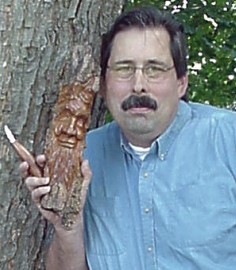

This book is a good
instructional woodcarving book, but it's greatest feature is
that it is a “good read”. It's one of my
favorites, and I'm a little embarrassed that I haven't reviewed it
here sooner. What does  the
term “good read” mean? It means that you will want to soak in ALL the
text, cover to cover. Do not just scan the pictures
and/or use only the sections that have the projects or techniques you
need. I have many books that are fine reference books. I
scan them quickly, decide they are worth buying, scan them again, maybe
carefully read one or two section, and then mentally file them away so
I can recall there contents and lay hands on them when the need arises.
Not this book... this is the type of woodcarving book that deserves to
be read.
the
term “good read” mean? It means that you will want to soak in ALL the
text, cover to cover. Do not just scan the pictures
and/or use only the sections that have the projects or techniques you
need. I have many books that are fine reference books. I
scan them quickly, decide they are worth buying, scan them again, maybe
carefully read one or two section, and then mentally file them away so
I can recall there contents and lay hands on them when the need arises.
Not this book... this is the type of woodcarving book that deserves to
be read.
When I started writing things for Mohawk Valley Art and
Woodcarving Association's newsletter, I often prefaced the article with
a relevant quote. Many of my favorites came from this book.
They were gems such as "I know it is a good habit to jot down ideas,
catching them like slippery fishes as they swim briefly through our
heads", and "Thanks to photography you can browse through time and
space to view a vast range of carved work. Don't be overawed by
these illustrious names and works, or feel you are in competition with
them; just breathe them in and have joy". There are more, but
I'll leave those for you to find on your own. Hopefully these
teasers illustrate how "Elements of Woodcarving" is a "good read".
Most of the
book alternates between lettered sections which deal with theories of
the carving process and numbered chapters which hold a project of
Chris's for example, but never illustrates it step-by-step. I
suspect there's a logical flow to it, but don't feel it's necessary to
analyze and describe it to you since it should be read as a whole
anyway. Try to absorb it all, once through at least, before you
try to apply any of it. Many times on the e-mail lists
and forums the issue of whether woodcarving is an art or a
craft has been debated. It can be either, depending solely
on the desire, skill level, and attitude of the woodcarver
themselves. What Chris Pye does here is describes the processes
that occur when woodcarving is an Art, and, no matter how new you are
to woodcarving , there should be a glimpse of yourself in there.
My favorite chapter of the book? It would be
the chapter dedicated to his mentor, Gino Masero. Through
the writing there is obviously a deep connection between Mr. Pye and
his former teacher. The chapter is also the location of the
most inspirational (for me) carving in the book. This is ironic
in a way since the carving is one of Mr. Masero's works. On page
137 there is a carving of St. Francis of Assisi playing a violin;
patched robe, folds, clean tools marks, blissful closed eye
expression. Everything about the carving tells you how absorbed
in his music the subject is, and makes you look it over again and
again. Again and again until, finally, I noticed St. Francis was
not actually holding a violin, but two sticks, probably firewood, and
I'm thoroughly convinced that would have been the same viewing sequence
if it had not been a photograph.
A brief tour:
 No
nit picking for this book, just an observation. This is not a
beginners book. If you're looking for a book to help you with the
basics you need to go elsewhere. This would be a good second
book, and don't wait until you think your ready for the intermediate or
advanced carving levels. What you find in this book may be beyond
your current abilities, but if you find you enjoy carving wood, that
won't last long. To echo his advice on viewing the works of others,
don't be overawed by what you find in this book, just breath it in and
have joy. So Gang, keep them edges keen, the chips piled high,
and make sure to put the books down once in a while to carve wood.
No
nit picking for this book, just an observation. This is not a
beginners book. If you're looking for a book to help you with the
basics you need to go elsewhere. This would be a good second
book, and don't wait until you think your ready for the intermediate or
advanced carving levels. What you find in this book may be beyond
your current abilities, but if you find you enjoy carving wood, that
won't last long. To echo his advice on viewing the works of others,
don't be overawed by what you find in this book, just breath it in and
have joy. So Gang, keep them edges keen, the chips piled high,
and make sure to put the books down once in a while to carve wood.
Keep on Carvin'
-Mike Bloomquist->
 Mike
Bloomquist is a carver
and carving teacher, and a regular contributor to WOM.
Mike
Bloomquist is a carver
and carving teacher, and a regular contributor to WOM.
You may visit Mike's web site, Wooden Dreams Woodcarving HERE or email him at m.bloomquistATverizonDOTnet.